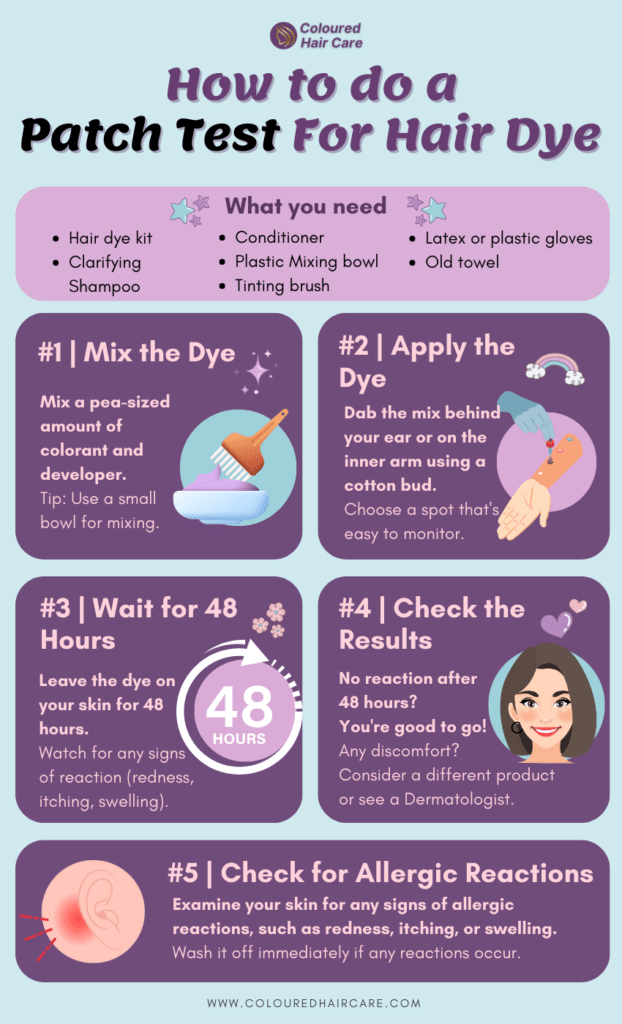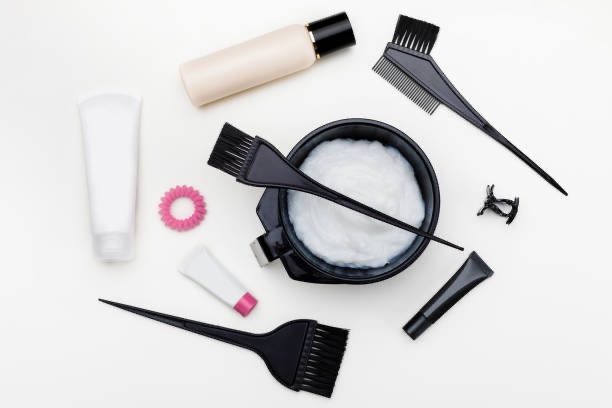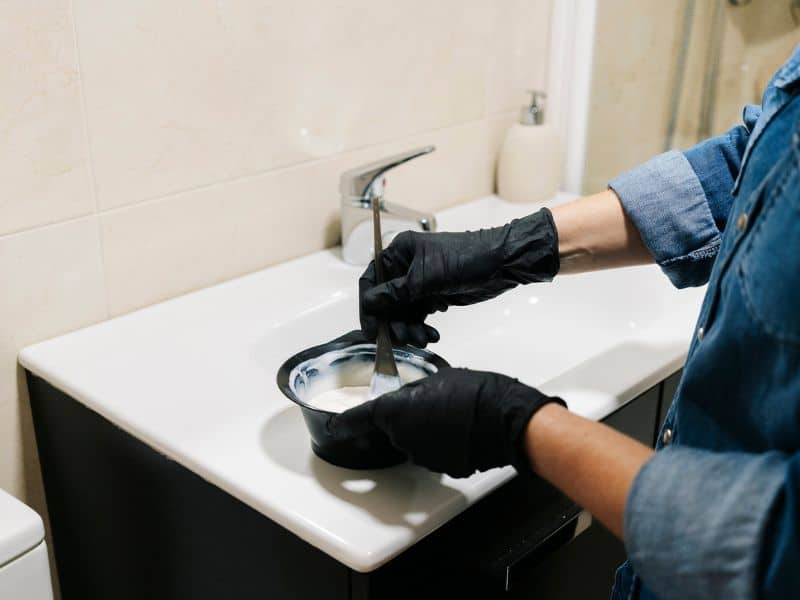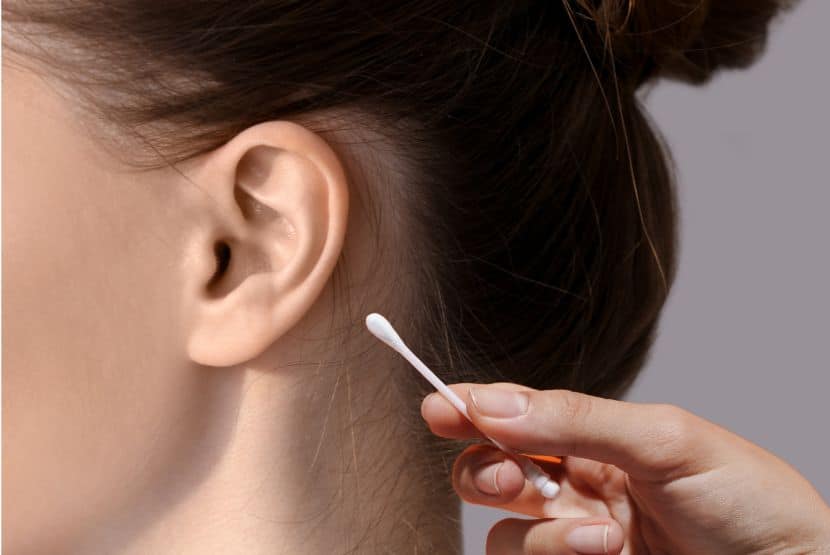You’re ready for a new do, a new you and a fabulous new color. You might be taking the plunge with bleach, or maybe you’re topping up your roots with a hair dye you’ve never used before.
All of these are reasons why you’ll need to know how to do a patch test for hair dye.
We’re here with everything you need to know about patch tests, how to do them and why it’s so important not to skip, even if you’ve been using hair dye for years. Read on!

Table of Contents
- What is a patch test?
- Why do I need to do a patch test?
- When Should You Do a Patch Test?
- Where On The Body Do You Do a Patch Test?
- How long does a patch test take?
- How to do a patch test for hair dye step-by-step.
- Step 1: Mix your hair dye.
- Step 2: Apply the dye.
- Step 3: Wait and watch.
- Step 4: No reaction? No problem.
- Watch and Learn: How to do a hair dye patch by Dr Amee Daxini.
- What happens if I am allergic to hair dye?
- Guide to the perfect patch test.
- Parting words
What is a patch test?
A patch test is a very important test you carry out to check that you’re not going to have any nasty allergic reactions to a product.
It’s typically carried out 48 hours before you want to dye your hair. This gives it enough time for your skin to react if it’s going to.
Certain chemicals and ingredients in hair dye can cause adverse allergic reactions and doing this check is a safe way of making sure your hair dye is not going to swell up your head and put you in hospital.
This is important every time, even if you’ve used the same hair dye before.
Why? Because Your Skin Can Change: Your skin can develop new allergies at any time.
This can happen even with products you’ve used before without problems. The NHS says that skin allergies can develop over time. WebMed agrees and advises a patch test every time you dye your hair to avoid any surprise allergic reactions.
Patch tests are not just for hair dye products either. It’s wise to test for allergens if you have sensitive skin and are trying new cosmetics, moisturisers, soap, or topical creams.
It’s often confused with a hair dye strand test. But a strand test is nothing to do with allergies. It’s a test that involves putting hair dye on a few strands of hair to check that the hair dye color result is the one you really want.
Expert Insights
“A patch test is a test where Hairdressers put a quarter size spot of mixed hair dye in the bend of your elbow or on your neck. We then watch it and wait. If any Reddish color or rash shows up? You are allergic to the dye. It can be other chemical services too. Permanent Waves, Straightening etc.”
Sharon Allred Williams, Cosmetologist
Why do I need to do a patch test?
Plenty of people skip this part of hair dyeing to save time or because they think the hair dye won’t affect them.
But when it comes to home hair dyeing, even if you’re used to certain brands, they can still cause a reaction.
So it’s best to do this quick and simple test, be safe and check rather than rush into something that could have nasty results.

Expert Insights
“Allergic reactions can b cumulative in nature. Always, always, always do a patch test on any hair dyes, even if you have used them for years. Things can change overnight.”
Karen Marie Shelton, CEO & Founder of HairBoutique.com
When Should You Do a Patch Test?
- Before Every Hair Dye Session: Always do this, even if it’s with your usual hair dye.
- When Trying a New Product: New brand or color? Patch test first.
- If Your Health Changes: If your health changes or you start new meds, it’s a good idea to do a patch test again.
Where On The Body Do You Do a Patch Test?
The AAD suggests good areas to perform a skin test may include the inside of the arm or bend of the elbow.
Most hairdressers will apply it behind the ear where it is less likely to rub off.
You can also try applying the hair dye onto skin where there is little-to-no hair growth (such as your forearm) followed by an inconspicuous spot like inside your elbow crease.
It actually doesn’t matter WHERE you apply the dye as you’re testing your body’s reaction to it, not just your hair and head.
The most common areas of sensitivity on the body are the neck, chest, back of arms, hands and lower legs. So any of these spots will do!
Expert Insights
“The patch test will show an allergic reaction. But, if you have a sensitivity, it might not show that. You can use a sensitive scalp developer. This is what I use on some clients who are sensitive to the developer.”
Allison Kosters, Hairstylist & Cosmetologist
How long does a patch test take?
There are few things more important in the world of beauty than ensuring your skin isn’t irritated or broken by the products you use.
You’ll need to do the test at least 24-48 hours before. This is to give the dye enough time to be on your skin and know if it’s going to cause any adverse reactions.
Try it in the morning so you have a whole day to watch for reactions.
Though this may seem time-consuming and unnecessary, having a little patience will help ensure that you get your perfect hair color without any drama.
Expert Insights
“Hair color has come a long way and is very safe. But it is a chemical, so if you have a sensitive scalp or have allergies, be sure to do a patch test on your skin. The only true natural hair color is henna and that’s a little too natural for me.”
Kris Kujawinski, Hairstylist and Colorist at the Lilltle Hair Shoppe, NYC
How to do a patch test for hair dye step-by-step.
Follow these four easy steps to do your patch test at home!
Step 1: Mix your hair dye.

To test the dye, you’ll have to open it and mix a small amount of the developer and the colorant as if you were going to dye your hair.
It only needs to be a pea-sized amount of each substance. Don’t mix the whole activator and dye together as it won’t last for 48 hours until you dye your hair.
TOP TIP! Hair dye is often on offer. You can buy two boxes of hair dye and use one for the test!
Step 2: Apply the dye.

Using a cotton bud or Q-tip, dab a small amount of dye on a clean area of skin.
We recommend placing it is behind your ear on your neck. If you do have a reaction, it won’t be too obvious or unsightly.
However, some people prefer to place it on their inner arm. This is fine too.
Step 3: Wait and watch.

Once the dye is dry, leave it on for 48 hours to do its thing.
If it starts to itch, burn or a rash, swelling or redness begins to develop, it’s safe to say your skin is not happy with this hair dye and you need to wash it off immediately.
Allergic reactions can be very serious. If your symptoms are worsening, you may need to call emergency services for help.
Expert Insights
“If you discover you have an allergy to hair dye and your primary goal is to conceal grey hairs, you’ll be pleased to know there are numerous semi-permanent hair color options available that lack PPD, the common allergen in hair colorants. Always remember to check the ingredient list to ensure the product does not contain p-Phenylenediamine.“
Stephanie Johnson, Senior Cosmetologist/Trichologist
What to Watch Out For During Your Patch Test.
When you’re doing a patch test, it’s not just about waiting for 48 hours. You need to keep an eye on the test area for any signs that your skin might not be happy with the hair dye. Here’s what to look out for:
1. Redness or Swelling: If the area where you applied the dye gets red or swollen, that’s a sign your skin is reacting.
2. Itching or Burning Sensation: Feeling itchy or like the area is burning? That’s not normal and could mean you’re allergic.
3. Blisters or Rash: Any blisters or rash appearing where you did the test? This is a strong reaction and you should definitely avoid using the dye.
4. General Discomfort: Even if it’s not a clear rash or swelling, any discomfort in the area is a reason to be cautious.
If you notice any of these signs, wash off the dye from the test area immediately. It’s better to choose a different hair dye, ideally one that’s hypoallergenic or designed for sensitive skin.
Remember, even a small reaction during a patch test can turn into a bigger problem if you use the dye all over your hair. It’s always best to play it safe.
You find out more about the types of allergic reactions you can have to hair dye on the NHS website here.
Step 4: No reaction? No problem.
If 48 hours later, your results are clear and everything looks as it should, you can do a little skip for joy and get on with your hair dyeing process! Good luck!
Watch and Learn: How to do a hair dye patch by Dr Amee Daxini.
Here’s a simple explanation of how to do a patch test and why it’s important by practising Dermatologist Dr Amee Daxini.
What happens if I am allergic to hair dye?
Healthline tells ust that the ingredient in hair dyes most often responsible for a reaction is para-phenylenediamine (PPD), which is used in many permanent hair dyes.
There are safe and ‘natural’ hair dyes you can try, but you will need to read the ingredients on the box very carefully to make sure they are truly PPD free.
PPD is the most common allergen, but you should visit your doctor if you have had a reaction so they can pin point the cause and make recommendations that are right for you.
No one should be deprived of coloring their hair! So play it safe and make sure you do a hair dye test!
Guide to the perfect patch test.
Do’s
- Do conduct the test 48 hours before you are due to dye your hair. Any time is fine but we prefer the morning so we have all day to watch and wash it off if we need to.
- Do mix up only a small amount of hair dye for testing, not the whole bottle (unless you have bought an extra box especially for the test).
- Do apply it to the back of your ear on your neck. It is ok to apply it elsewhere to test the contact of it on your skin. But since this is hair dye, we’d opt for your head.
- Do wash it off immediately if you are experiencing any adverse reactions.
Don’ts
- Don’t skip it! Even if you are a hair dyeing pro, you can still react badly to the chemicals. In fact, the more you have been exposed to hair dye, the more likely you are to have a reaction.
- Don’t leave it on if you start to feel any itching, burning or swelling or if you notice a rash developing. Wash it off immediately. That hair dye is not for you!
- Don’t just try another hair dye brand if you do have a reaction. The chances are it will contain the same ingredients you are reacting to. See your doctor to get to the root of the problem.
Parting words
In this blog post, we’ve covered the basics of how to do a patch test for hair dye.
We hope you found our tips helpful!
It’s important that you take precautions when using any product that could potentially have an allergic reaction on your skin or scalp.
But keep in mind, what we’ve shared here isn’t medical advice. Performing a patch test as outlined in this guide is a precautionary measure and not a definitive means to diagnose allergic reactions.
Always prioritize your health and safety, and seek medical attention if you experience adverse reactions from any hair dye product.
Every person’s skin is unique, and if you have any concerns or if you experience a reaction, it’s always best to consult a healthcare professional. They can provide personalized advice and safe alternatives.
We’re here to help you make your hair color dreams come true, safely and stylishly. If you’ve got any more hair care questions or need some color inspiration, just drop us a message at @colouredhaircare on social media. Happy coloring, and remember to always listen to your skin!

